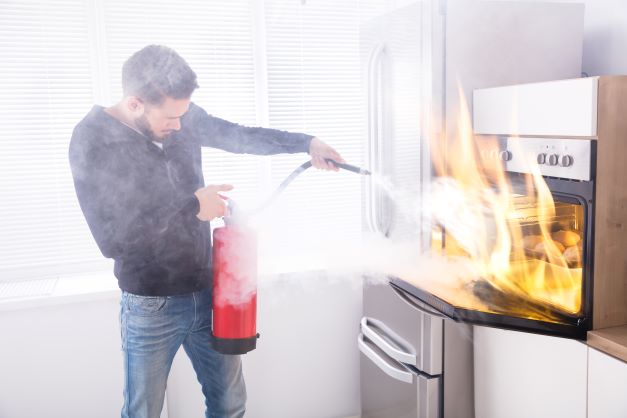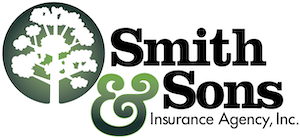
A fire extinguisher is a very effective tool for putting out a fire that is just getting started. While everyone can recognize one, very few of us have ever used one. Knowing how to properly use an extinguisher reduces the risk of a small fire developing into a larger fire and destroying your workplace or home. And if you’re caught on the fire side of an escape route, an extinguisher can provide a path to safety.
While fire extinguishers are useful tools, don’t hesitate to call 911 for help.
Types of fire extinguishers
There are several classes of fire extinguishers. The U.S. Fire Administration provides the following breakdown:
- Class A: Used on everyday materials like cloth, wood and paper
- Class B: Used on combustible and flammable liquids, including grease, gasoline, oil and paint
- Class C: Used on electrical equipment, such as appliances and power tools
- Class D: Used on flammable metals
- Class K: Used on vegetable oils, animal oils and fats in cooking appliances
You can find most of these types of extinguishers at a big box store, your local hardware store, or a fire prevention company. Or, call your local fire department and ask where you can get a good one.
Home fire extinguishers
Most home fire extinguishers are intended for grease fires that might occur in a kitchen pan or stove. These extinguishers are not designed for large-scale fires, but rather to catch fires in their incipient stage. Home fire extinguishers are relatively inexpensive and small.
When purchasing a home fire extinguisher, the U.S. Fire Administration suggests looking for one labeled multipurpose, such as an “A-B-C” extinguisher.
In my own home, I’ve got an “A-B-C” extinguisher that I keep under my kitchen sink. I will also set it outside if I am ever using the grill to cook. The unit is good for a stated period of time, at which point I will have it inspected or buy a new one.
Commercial fire extinguishers
Commercial fire extinguishers come in various sizes, but they are still small enough to be used on a small or incipient-stage fire.
The type of extinguisher available to you at work will depend on the setting. For example, commercial kitchens usually have Class K extinguishers.
Even if a commercial building is set-up with an automatic fire suppression system, it is still vital to have fire extinguishers located around the premises. This is especially true for commercial kitchens.
Where to keep fire extinguishers
Securely mount the extinguisher in a location that is easy to reach, but where you won’t be tempted to use it as a coat rack. Mounting the extinguisher not only ensures that it’s readily available in the event of a fire, but it also prevents delicate parts from being tampered with or broken.
Commercial property insurance companies will often send out property inspectors to the insured location(s). During these inspections, one of the most common recommendations or requirements is that the fire extinguisher be mounted about 4 feet off the ground in a highly visible area.
Do not mount your fire extinguisher behind a stove or other appliance, as this would require you to reach over the fire to access it.
As I mentioned, I always know where my fire extinguisher is located. So does everyone else in my household.
How to use a fire extinguisher
With a 2-pound unit, you have about 30 seconds of spray time. It’s imperative that you know how to correctly use an extinguisher — or risk running out of extinguishing agent amid a growing fire.
Remember the acronym PASS:
P — Pull the pin.
A — Aim the nozzle at the base of the flame.
S — Squeeze the trigger/handle.
S — Sweep the extinguisher slowly from side to side.
Even if you believe you have successfully extinguished the fire, call 911 anyway. The fire department will confirm that the fire is truly out and check electrical wiring for damage.
Learn how to PASS a fire extinguisher. It may help you prevent a potentially deadly fire.
Maybe the most common reason for a fire extinguisher NOT putting out a small fire is the “A” – aiming at the wrong place. Our eyes are drawn to the light of the flames and that is where we instinctually point a fire extinguisher. We want to make the flames go away, so we aim at the flames.
But as noted above, you extinguish the fire by putting out the flame at the base of the flame. The “base” means the fuel – the material that is burning. The paper, clothing, food, oil – whatever is on fire is actually fueling the flames. The chemicals in the extinguisher spray are supposed to keep that material from further fueling the fire.
Old Fire Extinguishers
Many times a property owner will have fire extinguishers around their premises, but forget how long they have had them. There should be a date on the tag of the fire extinguisher that says when the unit should be inspected, recharged or disposed of properly.
Be sure to check your fire extinguisher every 6 months (or more) for that date, or for any signs of problems.
You don’t want to find out in the heat of the moment that your old fire extinguisher is no good.
